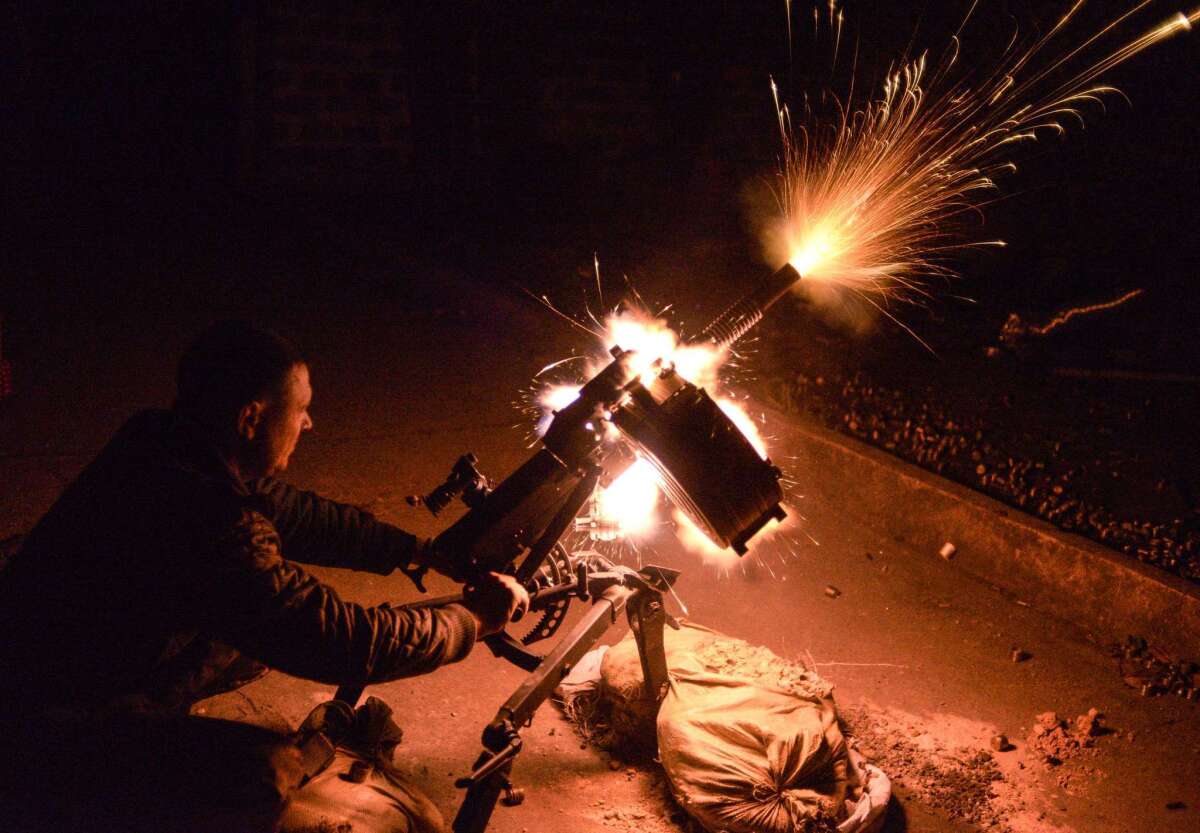Ukraine says it has never used cluster bombs in fight with separatists

- Share via
Reporting from Kiev, Ukraine — Ukrainian armed forces have never used prohibited weapons such as cluster bombs in their fight against pro-Russia separatists, a military spokesman insisted Tuesday after a rights group reported that it had documented a dozen instances in which the indiscriminate weapons were used in populated areas.
The report by Human Rights Watch also said there were circumstances, “while not conclusive,” suggesting that the separatists as well had used the munitions. Cluster bombs pack dozens or hundreds of small bomblets in a warhead that bursts open and scatters them over a wide area, often putting civilians at risk.
“It is shocking to see a weapon that most countries have banned used so extensively in eastern Ukraine,” Human Rights Watch senior arms researcher Mark Hiznay said of the group’s weeklong investigation of the use of cluster bombs in Donetsk, a city of 1 million residents before the conflict.
Cluster bombs leave a distinctive crater and fragmentation pattern, the rights group’s report noted, saying markings found helped the group determine that Ukrainian government weapons were used.
Col. Andriy Lysenko of the National Security and Defense Council sought to undercut the report, saying independent observers in battle-torn eastern Ukraine needed to be vigilant against incidents staged by the Russia-backed separatists.
“There are provocations every day. The terrorists set up these scenes, especially for Russian television,” Lysenko said, adding that Kiev doesn’t use cluster bombs by order of President Petro Poroshenko.
The Human Rights Watch report alleging government use of the weapons — banned by the Convention on Cluster Munitions — as recently as last week added to the mounting indications that a Sept. 5 cease-fire is having little effect on the bloody violence that has been consuming eastern Ukraine. Russia and Ukraine — as well as the United States — have not signed the international accord, which went into effect in 2010 among the more than 80 nations that have ratified it.
Although Lysenko said no Ukrainian government troops had been killed in the previous 24 hours, he made it clear that soldiers and volunteer militia fighters had been engaged by numerous attacks around Donetsk. His claim that many enemy fighters were killed in the sporadic battles appeared to be borne out by a report carried by Russia’s Tass news agency quoting the defense ministry of the proclaimed People’s Republic of Donetsk saying that 12 people had been killed and 27 wounded.
Five of the dead in Donetsk and 19 of the injured were gunmen and the rest were civilians, Tass reported.
“If the Ukrainian authorities talk about the truce, they lie,” the breakaway region’s so-called prime minister, Alexander Zakharchenko, was quoted by Tass as saying.
Lysenko, at his daily briefing in Kiev, was asked whether Russian troops had pulled back from the Ukrainian border, as Russian President Vladimir Putin said he had ordered. There were 17,600 Russian soldiers along the volatile border, purportedly for military exercises, when the Kremlin chief ordered them back to their permanent bases Sunday.
“We don’t have confirmation that they have pulled back,” Lysenko said, adding that initial indications of movement turned out to be short-lived. “The majority of the Russian forces are still there.”
The security spokesman also reported that a massive explosion in Donetsk on Monday that blew out windows for miles around a shuttered chemical plant was caused by an attempt by the separatist gunmen to restart production of explosives.
“The explosion occurred because the militants didn’t have the technical capabilities to carry out the production process,” Lysenko said, adding that he didn’t have information on casualties from the blast.
Use of heavy weapons and sophisticated munitions and technology has increased in recent weeks. About 400 people have been killed during the purported cease-fire. Since the fighting began in earnest in April, more than 3,700 have been killed, the United Nations’ human rights agency recently estimated.
Ukrainian authorities have lately accused the separatists of gaining more accurate targets for shelling thanks to the operation of drone aircraft from Russia to pinpoint targets. The drone sightings, especially over the front-line city of Mariupol on the Sea of Azov, have strengthened accusations from Ukrainian authorities and their Western allies that Russia is arming and assisting the insurgents in their quest to take territory and destabilize Ukraine.
Poroshenko in late August disbanded the dysfunctional parliament that had been left behind when his pro-Russia predecessor, Viktor Yanukovich, fled the country in February in the face of protests calling for greater ties to Europe. Early elections to replace the 450-seat Supreme Council are set for Sunday, and Ukrainian security officials warn that they are braced for further attacks on the eve of the parliamentary voting.
Putin seized Ukraine’s Crimea region after Yanukovich fled, claiming that Moscow was obliged to step in and protect the largely Russian-inhabited peninsula from those who took power in Kiev. Russia annexed Crimea in mid-March, inspiring the separatists in the Donetsk and Luhansk regions to seize government buildings and try to force similar territorial transfers.
Follow @cjwilliamslat for the latest international news 24/7
More to Read
Sign up for Essential California
The most important California stories and recommendations in your inbox every morning.
You may occasionally receive promotional content from the Los Angeles Times.











